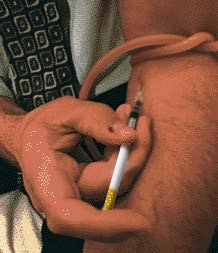 Additives in cigarettes
may make some brands far more addictive than others, according to research. Additives in cigarettes
may make some brands far more addictive than others, according to research.
-
- For the first time, scientists have measured the amount
of super-addictive "freebase" nicotine cigarettes deliver to
the smoker.
-
- Like crack cocaine, freebase nicotine vaporises and passes
rapidly through the lungs into the bloodstream. Because it reaches the
brain so quickly it is thought to be more addictive than normal nicotine.
-
- The research, by a team at Oregon Health and Science
University in Portland, could lead to ways of rating the addictiveness
of different brands.
-
- Scientists compared 11 brands available in America. They
found that some contained 10 to 20 times higher percentages of freebase
nicotine than experts had previously believed.
-
- Brands were compared with a laboratory "reference"
cigarette containing one per cent freebase nicotine. They varied greatly,
ranging from one per cent or two per cent to 36 per cent for a speciality
US brand called American Spirit. Marlboro contained up to 9.6 per cent
freebase nicotine. Other well known brands included Camel (2.7 per cent),
Winston (five per cent to 6.2 per cent) and Gauloises Blondes (5.7 per
cent to 7.5 per cent).
-
- Professor James Pankow, who led the study, reported in
the journal Chemical Research in Toxicology, said: "During smoking,
only the freebase form can volatise from a particle into the air in the
respiratory tract. Since scientists have shown that a drug becomes more
addictive when it is delivered to the brain more rapidly, freebase nicotine
levels in cigarette smoke thus are at the heart of the controversy regarding
the tobacco industry's use of additives like ammonia and urea, as well
as blending choices in cigarette design."
-
- A 1997 study led by Prof Pankow linked ammonia additives
with increased freebase nicotine levels in cigarettes. He found that on
its own, nicotine would not be very potent in the body but ammonia strips
away protons from surrounding molecules including nicotine, making it more
rapidly absorbed.
-
- The 1997 research confirmed assertions made by the American
Food and Drug Administration that widespread use of ammonia compounds in
cigarettes manufacturing was evidence that the industry manipulated the
delivery of nicotine in tobacco products.
-
- Professor Jack Henningfield, from the Johns Hopkins University
School of Medicine in Baltimore, Maryland, said: "It appears likely
that ingredients used in modern cigarette manufacture, such as ammonia
and urea, account for this addiction-enhancing effect."
-
- Professor Pankow said that in the United States there
were no formal tobacco industry or Food and Drug Administration guidelines
on appropriate levels of freebase nicotine in cigarettes. But the message
from the industry was that cigarettes contained only small percentages
of freebase nicotine. Only additives on a permitted list from the Department
of Health are allowed in cigarettes made in Britain.
-
- A spokesman for the Tobacco Manufacturers' Association
in the UK said: "Cigarettes manufactured here do abide by the permitted
list and may be quite different from those in America."
-
- A spokesman for Phillip Morris, the maker of Marlboro,
said: "Ammonia is a compound naturally present in tobacco leaf. Quite
simply, there is no safe cigarette. No one cigarette is any more or less
harmful or addictive than another. All cigarettes and their smoke are harmful
and addictive.
-
- "It is entirely inappropriate to start communicating
to consumers that there are distinctions in terms of harm or addictiveness
between various brands of cigarettes. If consumers are concerned about
the harm or addictiveness of smoking they should quit."
-
- Three men who featured as the most famous character in
tobacco advertising - the horse-riding Marlboro Man - have died from smoking-related
illnesses: David Millar Jnr in 1987 from emphysema, Wayne McLaren in 1992
after lung cancer spread to his brain, and David McLean in 1995 from lung
cancer.
-
-
- http://www.telegraph.co.uk/news/main.jhtml?xml=/news/2003/07/28/wcigs
28.xml&sSheet=/news/2003/07/28/ixnewstop.html
|